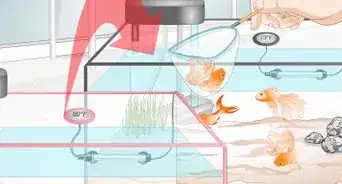This article was co-authored by Marshall Stephens. Marshall Stephens is an Aquarium Expert at Private Oceans Aquariums in West Palm Beach, Florida. Marshall has over 20 years of experience in the aquarium industry and focuses on captive-bred animals. They specialize in tropical and marine aquariums and are a contributor to the Loggerhead Marine life center in Jupiter Florida.
There are 9 references cited in this article, which can be found at the bottom of the page.
This article has been viewed 105,853 times.
If you suspect your fish is sick, it could because of a fungal infection. Fungal infections, such as Saprolegnia and Achyla infections, are common diseases in fish that typically occur if the fish has an injury or illness that weakens its immune system. They are highly contagious and can be fatal if not properly treated, so it’s important to treat your fish quickly and thoroughly. If your fish gets a fungal infection, it’s probably not life threatening but it’s important to treat it so you can keep your fish healthy and happy.[1]
Steps
Treating Your Fish
-
1Set up a treatment tank. Get a small tank where your fish will have enough space to move around a bit. Add water and bring it up the temperature to 70–77 °F (21–25 °C) with an aquarium heater. Test and treat the water to eliminate any chlorine in the water and to make sure the PH balance is correct, just as you would with a permanent aquarium. There you can monitor their behavior and treat it without polluting the rest of your aquarium.[2]
- The treatment tank does not need to be as big as your permanent tank. A tank that is 10–20 gallons (38–76 L) is typically plenty big for pet fish. The fish will only be there during treatment, which could be a few weeks, so they don’t need as much room as normal.[3]
-
2Separate any infected fish from uninfected fish. Take the sick fish out of their tank gently and put them in the treatment tank. Since fungal infections are extremely contagious, move your sick fish into the treatment tank as soon as possible.
- Even if all of your fish are infected, you should treat them in a temporary tank so that you can give their permanent tank a thorough cleaning while you are treating them.
Advertisement -
3Add a fungal treatment to the water. Purchase a fungal treatment from your veterinarian or from a pet supply store. They in a tablet or liquid form and should be administered carefully. Follow all instructions and warnings on the package. In most cases, you will add the treatment medication to the treatment tank and then keep your fish in the water for a set amount of time.
- Commonly suggested treatments include malachite green, potassium permanganate, formalin, and povidone iodine solutions.[4]
- In most cases, it’s easiest to give a fish medication with this type of bath treatment. This is especially true when treating an infection the exterior of the fish’s body.
- Holistic remedies rarely work with fish, so strong antibiotics/medicines are usually required.
-
4Give the infected fish a salt bath. Along with specific medication, salt baths can help fish with fungal infections. Add 1 tablespoon of aquarium salt per gallon of water in the quarantine tank. Next, mix until it has dissolved. Finally, add your fish and let it sit for 10 to 15 minutes before removing it and replacing the salt-water with clean, de-chlorinated water.
- Some fish, such as tetras, do not tolerate salt baths very well. However, other common fish, such as goldfish, tolerate it well.[5]
- You can continue to give your fish a salt bath every other day for a few weeks after recovery to ensure the infection is completely gone.
-
5Clean your fish quarantine tank every day or 2. In order to maintain a clean, sterile environment while the fish is recovering, it's important to keep the temporary bowl clean. This includes scrubbing the side of the tank and changing out about 20% of the water for new, clean water.
-
6Add your fish back to its aquarium once the infection is gone. When you can no longer see the discoloration on your fish it's time to move it back to its permanent home. Make sure your fish is completely free of fungal growth, is swimming, eating, and acting normally, and has been given at least 5 days after the infection has receded to rest and recoup its energy before moving it.
- When putting your fish into the main aquarium, watch carefully in case your other fish show aggression.
- Monitor all other fish for signs of fungal growth or abnormal/uncharacteristic behavior during and after treatment.
Preventing Infection and Treating Underlying Conditions
-
1Change your feeding schedule to create less waste in the tank. One common reason for fungal infections to occur is that there is too much organic matter floating around in the tank. A common cause of this is feeding a fish more food than it can eat. To stop this, give the fish smaller portions throughout the day.
- Feed your fish 2-3 times a day depending on size, species, and age.
- Once you have a new feeding routine established, do not change it or add food, as it can stress out an already stressed and possibly bloated fish.
-
2Clean your fish tank regularly and thoroughly. Remove the fish from your tank and give it a top to bottom cleaning at least once a month. Remove half the water and set it aside to return to the tank later. Take out all of the plants, toys, and gravel and rinse them in clean water. Then use a sponge to clean the sides and bottom of the tank. Finally, return the clean plants, toys, and gravel, pour back it the reserved water, and fill the aquarium back up with water until it is full.
- Don’t put your fish back in the tank until it is back up to its standard temperature.
- Doing a thorough cleaning once a month will keep excess organic matter, such as extra food and feces, from building up in the water.
-
3Assess your fish for related health problems. Most fungal infections occur because the fish already has compromised health. If you can get to the root of the problem, your fishes' immune system will be improved and they will be able to fight off the fungal infection more effectively.
- In many cases, fungal infections occur at the sight of previous infections or injuries to the fish. Once the surface is injured and broken, the fungus can easily take hold.
- Fungal infections are usually caused by an injury, bacterial infection, or parasitic infection.[6]
-
4Treat any other diseases your fish has. In many cases, a fungal infection occurs because your fish has an injury or disease that is weakening its immune system. If you make sure that the fish is healthy overall, it is unlikely to get a fungal infection.
- For example, if your fish has parasites, you should give it medicated food to eliminate the infection.[7]
Identifying a Fungal Infection
-
1Look for discoloration on the fish’s body. Fungal infections show up on the surface of your fish. Notice any discoloration on the scales of your fish and look for cotton-like growths on the surface.[8]
- With a fungal infection your fish will develop a white film or white patches on parts of its body. This may seem like general discoloration, but a closer look often reveals a white, fungus-like growth.
-
2Notice problems with the fish’s eyes. A fungal infection can occur on the fish’s eyes as well as its body. The fish will have enlarged, filmy-white eyes that may face upward or seem non-functional. If this is the case with your fish, treat it as you would any other fungal infection.[9]
-
3Look for changes in your fish's behavior. Fish will usually swim awkwardly and lie on the aquarium's bottom if they have an advanced fungal infection. They may also gasp for breath at the top of the water.[10]
- They may also stop eating if they are very ill.
- Spotting changes in behavior is typically easiest if you assess the health of your fish on a daily basis. If you know how your fish usually acts, you catch sickness quickly.
Community Q&A
-
QuestionWhat causes fungal infections in fish?
 wikiHow Staff EditorThis answer was written by one of our trained team of researchers who validated it for accuracy and comprehensiveness.
wikiHow Staff EditorThis answer was written by one of our trained team of researchers who validated it for accuracy and comprehensiveness.
Staff Answer wikiHow Staff EditorStaff AnswerFungal spores thrive naturally in fish tanks, and they usually don’t cause problems. However, if a fish is stressed, sick, or injured, it can become prone to fungal infections. If the tank is dirty or the water quality is poor, fungal infections are even more likely.
wikiHow Staff EditorStaff AnswerFungal spores thrive naturally in fish tanks, and they usually don’t cause problems. However, if a fish is stressed, sick, or injured, it can become prone to fungal infections. If the tank is dirty or the water quality is poor, fungal infections are even more likely. -
QuestionCan fungal infections kill fish?
 wikiHow Staff EditorThis answer was written by one of our trained team of researchers who validated it for accuracy and comprehensiveness.
wikiHow Staff EditorThis answer was written by one of our trained team of researchers who validated it for accuracy and comprehensiveness.
Staff Answer wikiHow Staff EditorStaff AnswerUnfortunately, yes. If you suspect that your fish has a fungal infection, it’s important to treat it quickly so that the infection doesn’t become fatal.
wikiHow Staff EditorStaff AnswerUnfortunately, yes. If you suspect that your fish has a fungal infection, it’s important to treat it quickly so that the infection doesn’t become fatal. -
QuestionCan fish fungus infect humans?
 wikiHow Staff EditorThis answer was written by one of our trained team of researchers who validated it for accuracy and comprehensiveness.
wikiHow Staff EditorThis answer was written by one of our trained team of researchers who validated it for accuracy and comprehensiveness.
Staff Answer wikiHow Staff EditorStaff AnswerWhile humans don’t typically catch fungal infections from fish, there are several bacterial infections you can catch from aquarium fish. You might get these infections from handling infected fish or cleaning the tank while you have open cuts or scrapes on your hands. To prevent infections, wash your hands with soap and warm water both before and after handling your tank or feeding your fish.
wikiHow Staff EditorStaff AnswerWhile humans don’t typically catch fungal infections from fish, there are several bacterial infections you can catch from aquarium fish. You might get these infections from handling infected fish or cleaning the tank while you have open cuts or scrapes on your hands. To prevent infections, wash your hands with soap and warm water both before and after handling your tank or feeding your fish.
Warnings
- Always wash your hands after handling anything in a fish's environment.⧼thumbs_response⧽
- Do not leave a sick fish in an aquarium with other fish, even if its ailment is not contagious. A sick fish can easily become stressed or be attacked by its tank mates if it is considered weak.⧼thumbs_response⧽
- Consider the fish's current state of comfort. If the fish is breathing heavily, not moving at all, or lying on its size, there is a good chance that it is in severe pain. If your animal is in pain or unable to swim at all, you may need to consider euthanasia.⧼thumbs_response⧽
Expert Interview
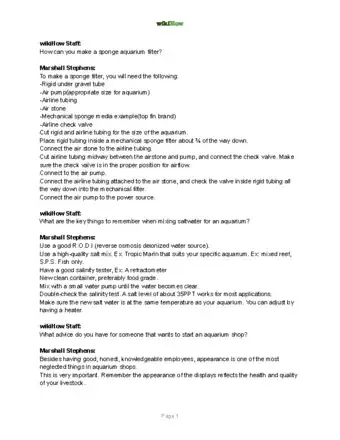
Thanks for reading our article! If you'd like to learn more about taking care of a fish, check out our in-depth interview with Marshall Stephens.
References
- ↑ https://www.ncbi.nlm.nih.gov/pubmed/12836630
- ↑ http://www.veterinaryworld.org/2008/February/Fungus%20disease%20in%20fish,%20diagnosis%20and%20treatment.pdf
- ↑ https://www.fishlore.com/QuarantineTankSetup.htm
- ↑ http://aquafind.com/articles/Fungal-Diseases-Of-Fish.php
- ↑ http://fisheries.tamu.edu/files/2013/09/The-Use-of-Salt-in-Aquaculture.pdf
- ↑ https://www.in.gov/dnr/fishwild/3395.htm
- ↑ https://fish.mongabay.com/disease.htm
- ↑ https://m.liveaquaria.com/article/80/?aid=80
- ↑ https://m.liveaquaria.com/article/80/?aid=80
About This Article
To treat fungal infections in fish, start by quarantining your sick fish in a separate 10-20 gallon tank so they don't get your other fish sick. Once you've moved the sick fish to the new tank, add a fungal treatment to the water, which you can find at a local pet store. You should also clean the quarantine tank and change out 20 percent of the water every 2 days so the water is clean and healthy for your recovering fish. Finally, once the infection is gone, wait 5 days before moving your fish back to their original tank. To learn how to prevent fungal infections in fish, scroll down!

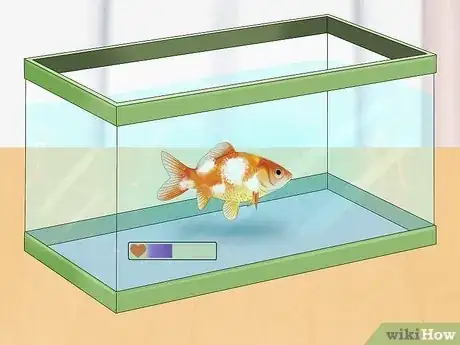

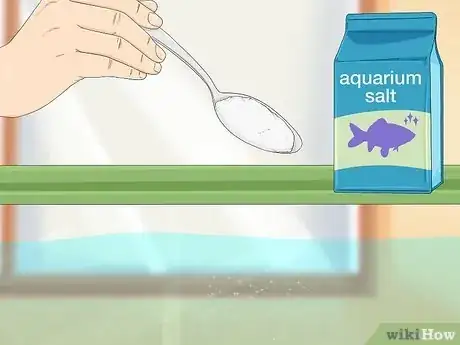
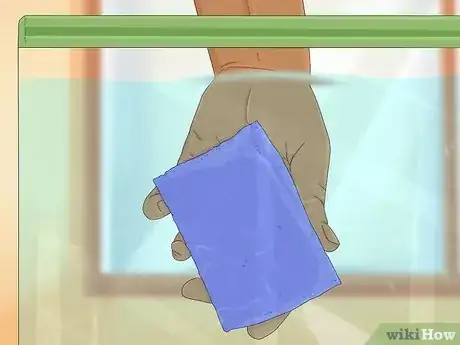

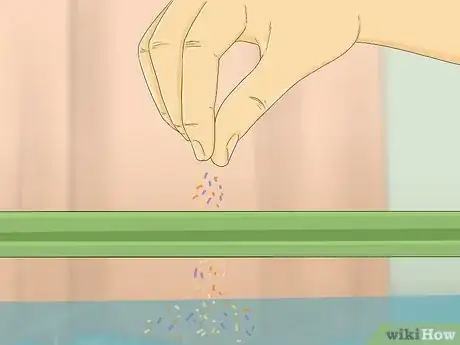

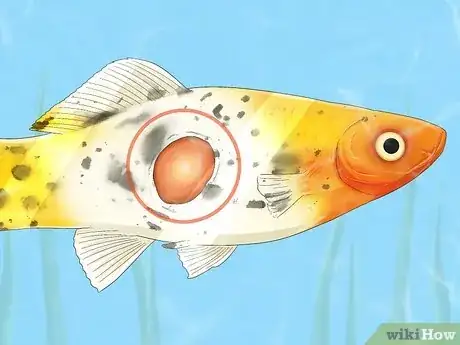

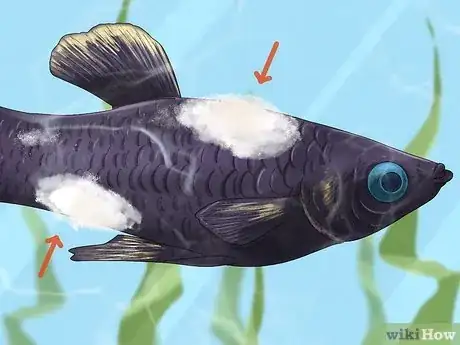

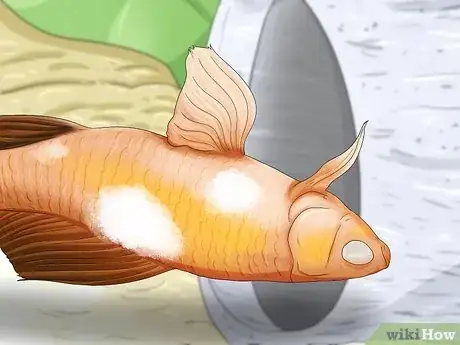





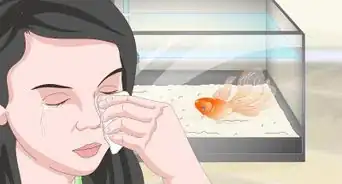
-Step-16.webp)

